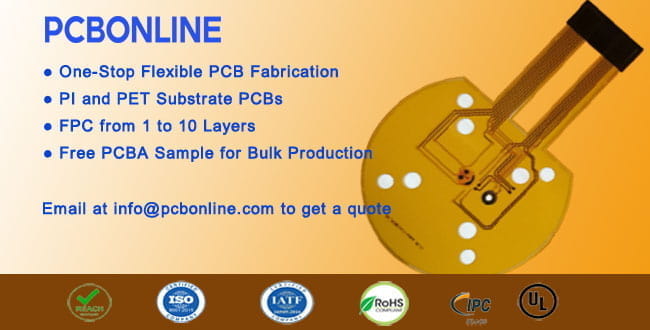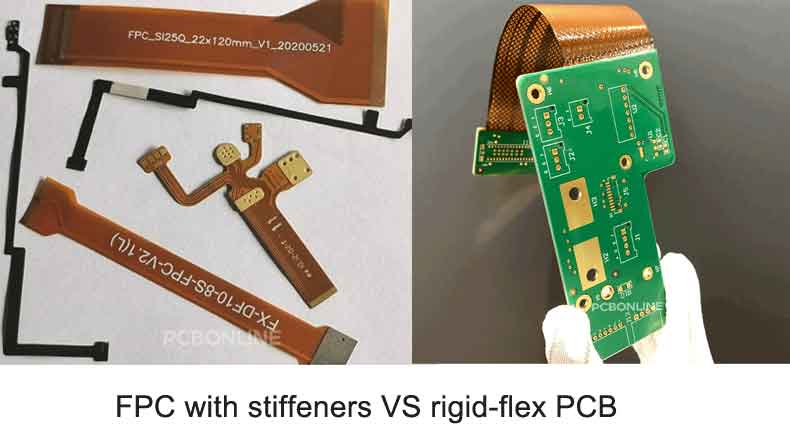Sometimes it is necessary to enforce some parts of a flexible PCB or FPC with stiffeners. PCB stiffeners are used to make a certain part of the board rigid so it can be easier to add/solder interconnects or components to the stiffer part.
There are three types of flex PCB stiffeners - PI stiffener, FR4 stiffener, and stainless steel stiffener.
The stiffener is not an electrical piece of the PCB. It is simply applied to provide mechanical support to the printed circuit board during the PCB assembly process.
Furthermore, flex PCB stiffeners include an increase in abrasion resistance, reinforcing solder joints, and better handling of the board for the automated process of pick-and-place.
![]()
Note:
You might note that the square area of the already small panel gets wasted, but on the design side, connector choice forces you to do this as connectors can suck.
In this article:
PI Stiffener, FR4 Stiffener, & Stainless Steel Stiffener PCB Manufacturer Good at Dealing with Stiffeners PCB Stiffener Thickness How are PCB Stiffeners Applied? The Difference Between Rigid-Flex and Rigidized Flex PCBsPI Stiffener, FR4 Stiffener, & Stainless Steel Stiffener

Flex PCB stiffeners are most commonly used on projects requiring increased stiffness and heat dissipation.
Among these stiffeners for flex PCBs, PI stiffeners are the most commonly used, FR4 stiffeners are the cheapest, and stainless steel stiffeners are used for applications with high-quality requirements.
PI Stiffener
PI is polyimide. PI stiffeners are commonly used to increase the thickness of the ZIF (zero insertion force) connector, where gold fingers contact and provide full support.
This way it allows tolerances in bending thickness and contours the component at the contact. The finger area bend thickness tolerance is typically ±0.002" and the width profile is ±0.003".
Besides, PI stiffeners are used to limit the bending ability of specific PCB areas to prepare an installation in the final assembly. The most common area to enhance would be the hole locations to provide additional wear resistance whenever wear problems occur.
PI stiffener is an excellent option for solder resistance and high bond strength. The most preferred locations for stiffener application are on the backside of the insertion gold fingers.
Sometimes you can simply pick the part of the PI stiffener that is not laminated or attached to the FPC body and easily insert the flexible printed circuit connector fingers into the ZIF socket or connector.
![]()
FR4 Stiffener
FR-4 can be the CCL of the rigid printed circuit board and is the most common material used for the PCB stiffener application in flex circuits. The main purpose of adopting an FR4 stiffener includes:
1. Providing flat enough support when the flexible PCB is in the pick-and-place and reflow processes.
2. Plated-through hole (PTH) components, it is important for the stiffeners to be placed on the same side of the flex PCB in which the components are inserted to allow direct access to solder pads.
In some cases, the customer wants to save money in the turnkey process of the project assembly, and for manufacturers to do so, they add an FR-4 frame on the border of the panelized PCB to successfully replace the SMT carrier.
![]()
In some flexible printed circuit board designs, the diameters of the holes of FR4 stiffeners are the same as the FPC. The holes will be extremely difficult to attach, and it could result in dis-alignment.
As a leading flex circuit manufacturer, PCBONLINE always ensures that the holes on the FR4 stiffener are up to 0.3mm bigger than those related holes on FPC to ensure good alignment.
Stainless Steel Stiffener
Stainless steel stiffeners are usually used for flexible circuit designs requiring anti-corrosion resistance, capability, robustness, and formability.
The stainless steel stiffener in flexible circuits is always added to the connecting fingers to stiffen the flexible printed board to facilitate assembly.
![]()
Multiple PCB Stiffener
Whenever applying PCB stiffeners, manufacturers ensure that the stiffener overlaps the flex PCB coverlay by 0.030" to relieve stress. In this case, the coverlay acts as a solder resist for the flexible printed circuit board.
Also, the same stiffener thickness should be maintained whenever using multiple stiffeners. After the process is completed, the stiffener strengthens the solder joints due to the increased abrasion resistance.
In the image below you can see a multi-layer flexible printed circuit board with FR4 stiffener on 3 different areas of the board.
![]()
Flex PCB Manufacturer Good at Dealing with Stiffeners
PCBONLINE is a one-stop flex PCB manufacturer that can add FR4, PI, and stainless steel stiffeners on flex PCBs.
Our PCB company fully understands the difficulties of the designing side to get the board to stay in spec, so we offer free one-on-one engineering support (DFX) to customers.

PCBONLINE fabricates and assembles high-quality flexible PCBs that can apply stiffeners.
PCBONLINE offers one-on-one tech support to help customers deal with any issues including stiffeners.
Free professional Gerber checks and BOM checks ensure the success of flex PCB and end products.
Besides stiffeners, PCBONLINE can add electromagnetic films, double-sided tape, and metal domes to flex PCBs.
PCBONLINE's flexible PCB manufacturing capability:
- Flex PCB Layer: 1 ~ 10
- Min. Mechanical Drilling Hole Diameter: 0.1mm
- Min. Laser Blind Hole Aperture: 0.075mm
- Max. Blind Hole Aspect Ratio: 0.8
- Blind Hole Buried Copper: No
- Min. Through-Hole Pad: 0.3mm
- Min. Blind Hole Capture/Login Pad: 0.275mm
- Minimum Line Width/Line Space:0.035/0.035mm
- Min. Interlayer Alignment: ±0.05mm
- Min. Hard Board Dielectric Layer Thickness: ±0.05mm
- Surface Finishes: ENIG, OSP, ENEPIG, Immersion Tin
If you need a flex PCB where gold fingers are needed, PI stiffeners or stainless steel stiffeners are expected on the FPC. If you have any issues with flex PCB stiffeners, such as thicknesses, you can contact PCBONLINE by email at info@pcbonline.com for free support. If you want to get a quote for flex PCB fabrication and assembly, also this email address.
PCB Stiffener Thickness
For designers, the thickness of PCB stiffeners is an important factor to consider because it affects the PCB specs, especially mil-specs.
PI stiffeners are available in several thicknesses: 0.001" (25μm), 0.002" (50μm), 0.003" (75μm), and 0.005" (125μm).
The thickness of FR4 stiffeners varies from 0.003"(0.08 mm) to 0.125" (3.18 mm).
The common thickness of stainless steel/aluminum stiffeners varies from 0.1mm (4mil) to 0.45mm (18mil).
|
Flex PCB Stiffener
|
Custom Thickness
|
Usual Thickness
|
|
FR4 Stiffener
|
0.2mm(8mil), 0.3mm(12mil), 0.4mm(16mil), 0.5mm(20mil), 0.6mm(24mil), 0.7mm(28mil), 0.8mm(32mil), 1.0mm(39mil), 1.2mm(47mil), 1.5mm(59mil), 2.0mm(80mil)
|
0.1mm(4mil), 0.9mm(35mil), 1.1mm(43mil), 1.3mm(51mil), 1.4mm(55mil), 1.6mm(63mil)
|
|
PI Stiffener
|
0.025mm(1mil), 0.1mm(4mil), 0.15mm(6mil), 0.2mm(8mil), 0.25mm(10mil)
|
0.075mm(3mil), 0.125mm(5mil), 0.175mm(7mil), 0.225mm(9mil), 0.275mm(11mil)
|
|
Stainless Steel Stiffener
|
0.1mm(4mil), 0.15mm(6mil), 0.2mm(8mil), 0.25mm(10mil), 0.3mm(12mil), 0.35mm(mil), 0.4mm(16mil), 0.5mm(20mil),
|
0.45mm(18mil)
|
How are PCB Stiffeners Applied?
Manufacturers ensure to attach the PCB stiffeners with plated-through hole components and that the stiffener is on the same side of the board where the components are inserted. This way they can access the solder pads and easily attach stiffeners to both sides of a part, but the assembly later will require a wide range of configurations to make sure that the printed board will not run into any complications down the road.
There are two main approaches to applying PCB stiffeners to a flexible printed circuit board - Thermal Bonding and pressure and Sensitive Adhesives (PSA). In the table below you can follow how each of both methods is executed:
|
Pressure-Sensitive Adhesives (PSA)
|
Thermal Bonding
|
|
Stiffeners are attached to the flex PCB by only using pressure
|
Stiffeners are attached to the flex PCB by using heat and pressure
|
|
Bond is not as strong
|
Stronger Bond
|
|
Used in bonding in IPC class 2 products (TV, laptops, consumer electronics, etc.)
|
Used in bonding in IPC class 3 products (military application, avionics, etc.)
|
|
More affordable
|
More expensive
|
|
The process takes less time
|
The process takes more time
|
|
Usually removed without damaging the circuit if care is taken while removing.
|
Will cause significant damage to the circuit while removed from the flex circuit.
|
PCB Stiffeners Common Uses
To illustrate better the applications of PCB stiffeners, the most common uses in the industry are listed:
- Maintaining proper thickness in the flexible PCB.
- Support for PCB components and connectors.
- Enforcing any specific area of the printed circuit board directors.
- Restricting flexible parts to the area they should be.
- Keep a certain area of the flexible printed board stable and flat.
- Fulfilling the ZIF connector requirements.
- Better board handling.
- Increasing the radius of bending at the inspection of rigid and curved portions (this will avoid stress on the flexible part during the multiple bending operations during the assembly).
- Reducing stress and pressure on the curved parts of the PCB.
- Connectors that require assembly or repeated insertion need PCB stiffeners to reveal pressure.
The Difference Between Rigid-Flex and Rigidized Flex PCBs
The rigidized flex PCB is bonded with a PCB stiffener to strengthen a certain area of the flexible surface to make the assembly process easier. As far as the common flexible circuit, it is laminated into a single flexible structure. There are no traces on the rigid part of the rigidized flex even on the pads. This rigid part only strengthens the rigidity of the location on which is applied and has nothing to do with functionality.

However, for the common rigid-flex PCB, both the rigid and the flexible layers are designed with traces that manufacturers connect via holes. In this case, this is not considered mechanical support, instead, it is an electrical connection for the rigid-flex board.
Bottom Line
PCB stiffeners enable the flex circuit to function more effectively and go through the assembly process flawlessly. There is a wide range of possible combinations with various types of PCB stiffeners depending on the end design. If you are not certain how PCB stiffeners will work with your flex-printed circuit board design, make sure to quote PCBONLINE. Our specialist will go into detail about the process and discuss using PCB stiffeners effectively. Contact PCBONLINE via email at info@pcbonline.com now to learn more or get a quote for flex PCB with stiffeners!
PCB fabrication at PCBONLINE.pdf




